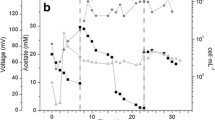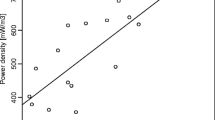Abstract
Several microbial associations were obtained from natural and anthropogenic sources. All of the associations grow well on glucose and significantly worse on acetate. We observed 80–95% glucose consumption during 3–5 days of growth. The oxidation of substrates by the cultures generates an electric potential difference between anode and cathode electrodes of a microbial fuel cell (MFC). The value of the potential difference depends on the nature of the association and the substrate and reaches 400–500 mV. The potential difference generation accompanied by a shift to the negative region of the medium redox potential (E h ) to — (400–500) mV. This indicates H2 evolution by the association cultures during oxidation of carbohydrates. Artificial redox mediators, such as tetramethyl-p-phenylenediamine, phenazine methosulfate, and benzyl viologen, were able to increase up to 15% the difference in electrical potential across the electrodes of the MFC. It is assumed that an increase in the potential difference across the electrodes induced by the redox mediators is due to their direct involvement in the transfer of electrons from the bacteria in the incubation medium to the MFC anode electrode. The direct measurement of current and potential difference on the electrodes in a short-circuit mode shows that the internal resistance of the MFC is equal to 1 kΩ and the power reaches 5 μW. Undoubtedly, this testifies to the low efficiency developed by the MFE.
Similar content being viewed by others
References
Angenent, L.T., Karim, K., AL-Dahhan, M.H., Wrenn, B.A., and Domiguez-Espinosa, R., Production of bioenergy and biochemicals from industrial and agricultural wastewater, Trends Biotechnol., 2004, vol. 22, no. 8, pp. 477–486.
Phaem, C.A., Jung, S.J., Phung, N.T., Lee, J., Chang, I.C., Kim, B.H., Yi, H., and Chan, J., FEMS Microbiol. Letts., 2003, vol. 223, pp. 129–134.
Rabaey, K., Lissens, G., Siciliano, S.D., and Verstraete, W., A microbial fuel cells capable of converting glucose to electricity and high rate and efficiency, Biotechnol. Lett., 2003, vol. 25, pp. 1531–1535.
Kim, J.R., Jung, S.H., Regan, J.M., and Elogan, B., Electricity generation and microbial community analysis of alcohol powered microbial fuel cells, Bioresour. Technol., 2007, vol. 98, pp. 2568–2577.
Deforivich, V.S., Knighton, M.C., Pagaling, E., Ward, B., Free, A., and Goryanin, I., Novel electrochemically active bacterium phylogenetically related to Arcobacter butzleri, isolated from a microbial fuel cell, Appl. Environ. Microbiol., 2009, vol. 75, no. 23, pp. 7326–7334.
Torres, C.I., Marcus, A.K., and Rittmann, B.E., Kinetics of consumption of fermentation products by anode-respiring bacteria, Appl. Microbiol. Biotechnol., 2007.
Roden, E.E., Kappler, A., Bauer, I., Jiang, J., Paul, A., Stoesser, R., Konishi, H., and Xu, H., Extracellular electron transfer through microbial reduction of solid phase humic subsaces, Nature Geoscience, 2010, vol. 3, pp. 417–421.
Park, D.H. and Zeikus, G., Electricity generation in microbial fuel cells using-neutral red as an electronophore, Appl. Environ. Microbiol., 2000, vol. 66, no. 4, pp. 1292–1297.
Haipham, T., Boon, N., Alterman, P., Clauwaert, P., and Schamphelaire De, L., Metabolited produced by pseudomonas sp. enable gram-positive bacterium to achieve extracellular electron transfer, Appl. Microbiol. Biotechnol., 2008, vol. 77, pp. 1119–1129.
Barsky, E.L., Dol’nikova, G.A., Savanina, Ya.V., Belousova, E.E., Karpova, E.Yu., Dedov, A.G., and Lobakova, E.S., Conversion of stillage carbohydrates by associations of microorganisms immobilized on polymer matrices, Moscow Univ. Biol. Sci. Bull, 2013, vol. 68, no. 3, pp. 124–130.
Metody khimii uglevodov (Methods of Carbohydrate Chemistry), Kochetkov, N.K., Ed., Moscow, 1967.
Pinevich, A.V., Biologiya prokariot (Biology of Prokaryotes), St. Petersburg: S.-Peterb. Gos. Univ., 2007, vol. 2.
Barsky, E.L., Lebedeva, A.F., and Savanina, Ya.V., Changes in the redox potential of the culture medium of the bacterium Pseudomonas diminuta resistant to heavy metals: the relationship with the release of metallothionein-like proteins from cells, Vestn. Mosk. Univ. Ser. 16: Biol., 1999, no. 2, pp. 11–15.
Lebedeva, A.F., Savanina, Ya.V., and Barsky, E.L., Changes in the redox potential and carbohydrate content in the medium during batch and dialysis cultivation of the cyanobacterium Anacystis nidulans and bacterium Pseudomonas diminuta, Vestn. Mosk. Univ., Ser. 16: Biol., 2002, no. 2, pp. 24–29.
Author information
Authors and Affiliations
Corresponding author
Additional information
Original Russian Text © E.L. Barsky, G.A. Dolnikova, Ya.V. Savanina, E.S. Lobakova, 2014, published in Vestnik Moskovskogo Universiteta. Biologiya, 2014, No. 3, pp. 24–29.
About this article
Cite this article
Barsky, E.L., Dolnikova, G.A., Savanina, Y.V. et al. Generation of electric potential difference across the electrodes of the microbial fuel cell in the anaerobic oxidation of substrates by microbial associations. Moscow Univ. Biol.Sci. Bull. 69, 113–117 (2014). https://doi.org/10.3103/S009639251403002X
Received:
Published:
Issue Date:
DOI: https://doi.org/10.3103/S009639251403002X




